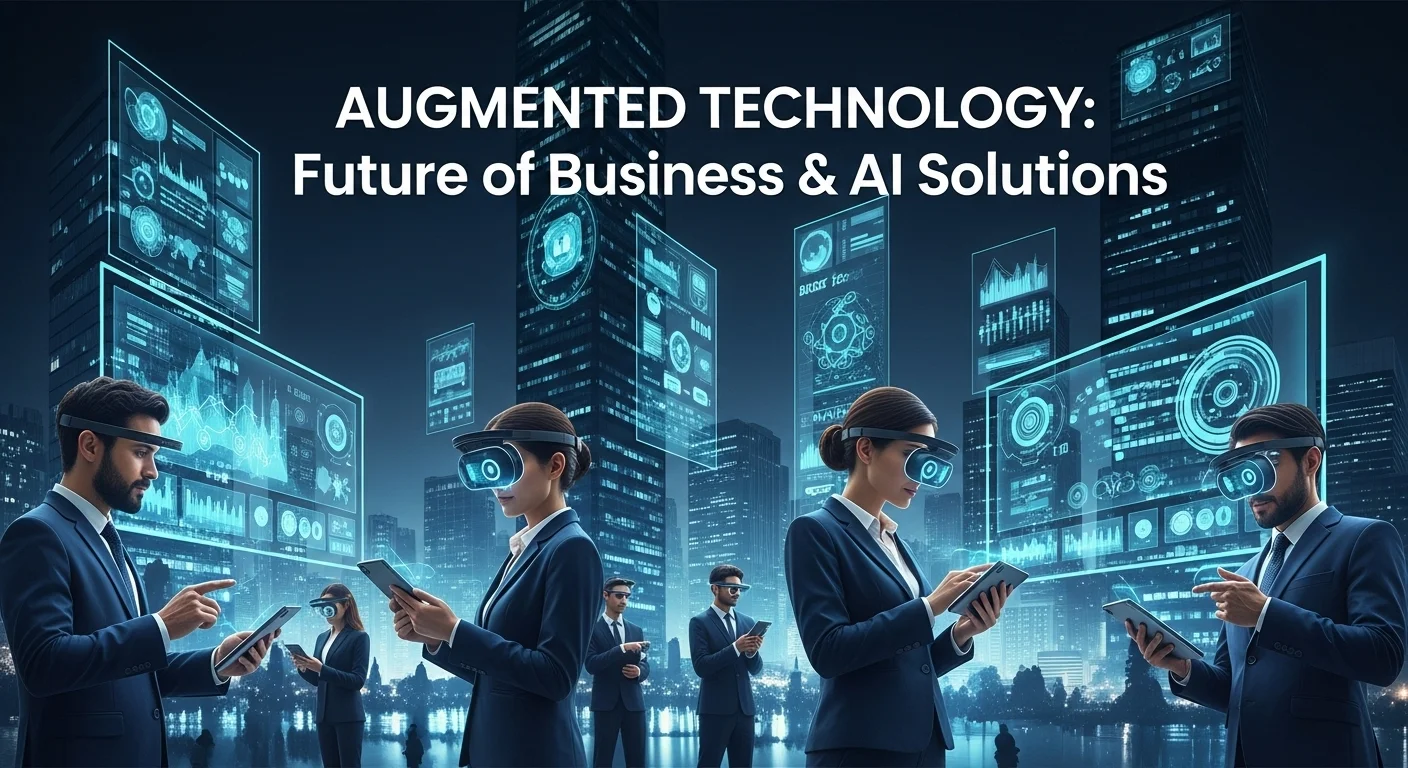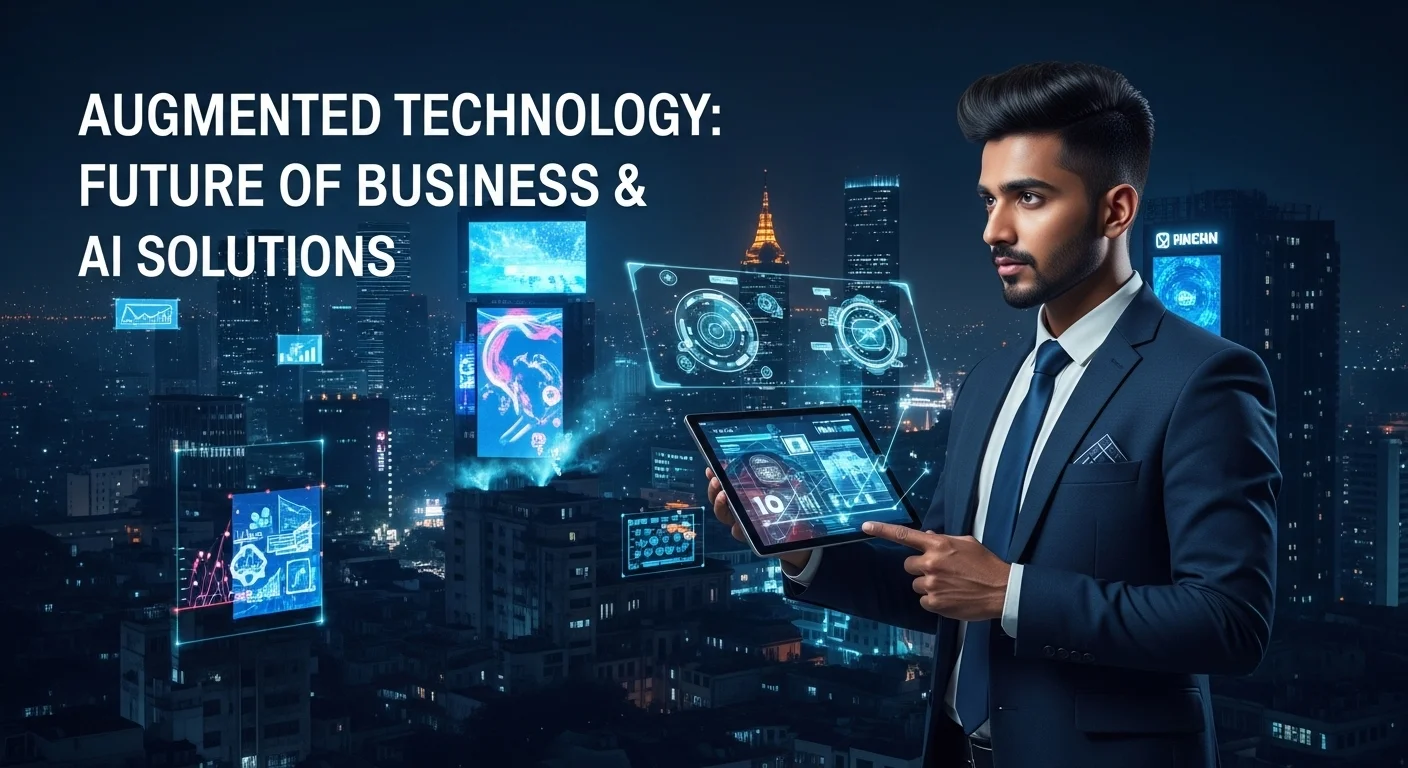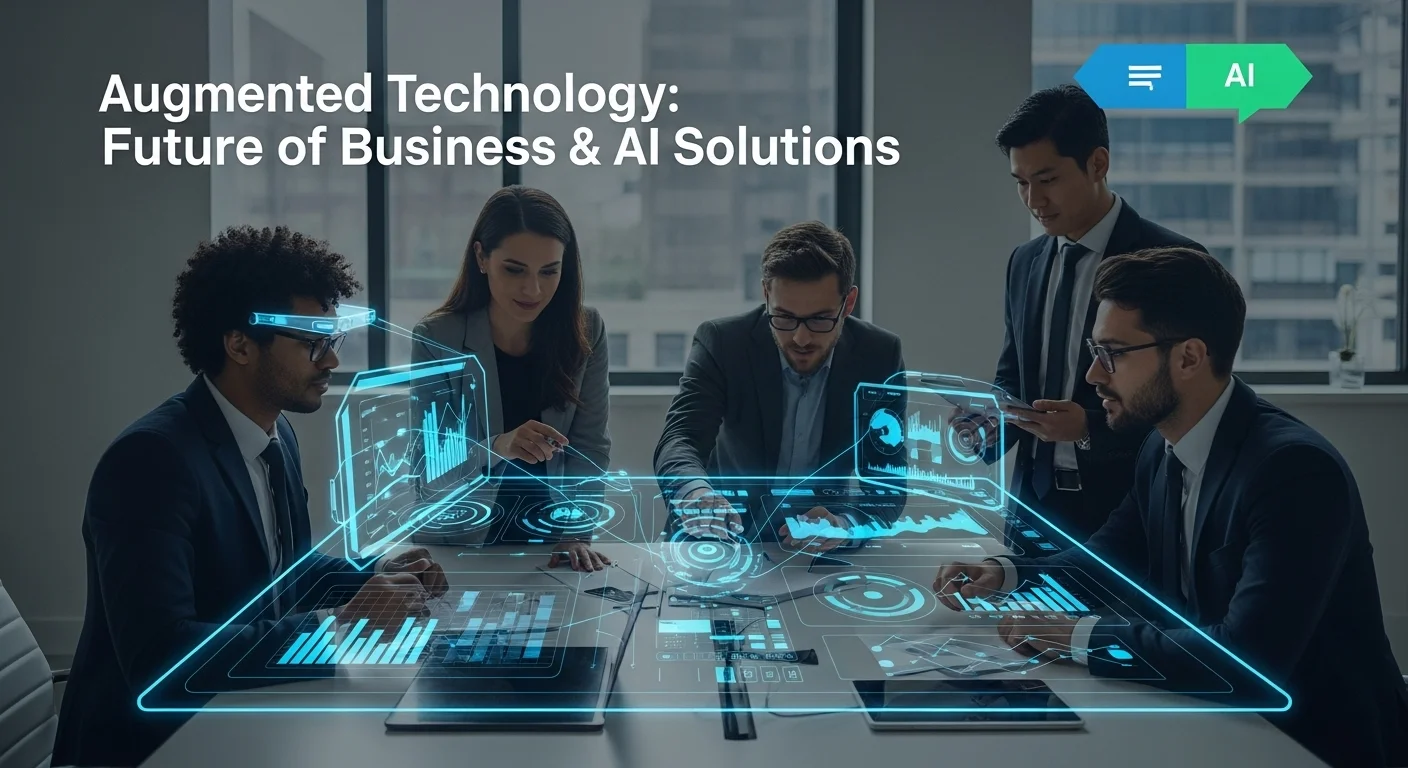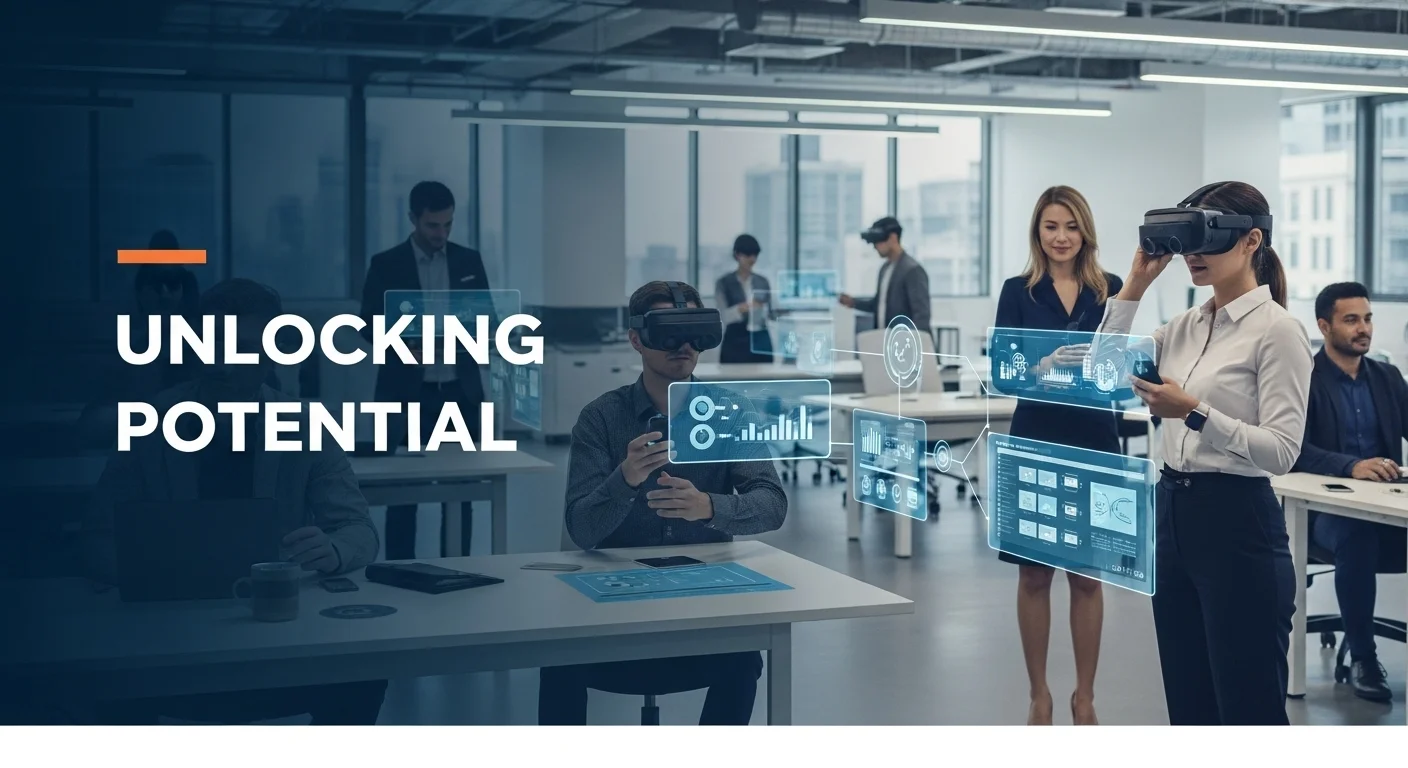Augmented Technology: How AR and AI Are Really Changing Business

Executive Summary
Augmented Technology is fundamentally changing how we connect with the digital world by weaving it directly into our physical reality. I've spent years watching this field evolve, and it really boils down to two game-changing pillars: Augmented Reality (AR) and Augmented Intelligence. In this article, we'll walk through the journey of AR, from the fun apps on your phone to the powerful augmented reality glasses changing industries. We'll also dive into Augmented Intelligence, a powerful partnership where AI doesn't replace us but makes us smarter and more efficient. My goal is to show you the real-world business applications—how using augmented intelligence in your business can lead to better decisions, smoother operations, and incredible value. Whether you're a tech enthusiast or a business leader, this guide will give you the insights to get ahead and stay there.
Table of Contents
What is Augmented and why is it important in Technology?
In all my years working with tech, the word 'augmented' has become one of the most exciting. It’s not just about adding things; it's about enhancing our own reality and our own minds with digital information. Think of it as a shift from looking down at a screen to having useful information appear right where you need it, in the world around you. This isn't just a small step; it's a complete reimagining of how we interact with computers. The real importance of augmented technology is its power to make our lives easier and more efficient. It helps reduce mental strain, makes learning faster, and gives us new abilities across almost any field you can imagine. At its heart, augmented technology is about empowering people by blending the digital and physical worlds. This revolution is being led by two key areas: Augmented Reality (AR), which enhances what we see and hear, and Augmented Intelligence, which boosts how we think.
The Rise of Augmented Reality (AR)
Augmented reality is the one you've probably seen. It's the technology that overlays computer-generated images and information onto the real world, creating a single, interactive view. Unlike Virtual Reality (VR), which puts you in a completely digital world, AR just adds layers to the reality you're already in. I remember when AR was just a concept in university labs, requiring bulky equipment. But then came the smartphone. Suddenly, with powerful cameras and processors in everyone's pocket, AR became accessible to millions through simple apps. An AR system basically needs a brain (processor), senses (accelerometers, gyroscopes), eyes (a camera and a display), and a way to get input. It uses something called computer vision to recognize what it's seeing, and then projects digital info onto it. The real secret sauce behind modern AR is a technology called SLAM (Simultaneous Localization and Mapping). This lets a device build a map of its surroundings while also knowing where it is within that map. It's what makes a digital object look like it's actually sitting on your coffee table and lets you walk around it.
The Hardware Evolution: Augmented Reality Glasses
While phones brought AR to the mainstream, the dream has always been a hands-free experience. That’s where augmented reality glasses come in. These devices aim to make the digital overlay a constant, seamless part of your vision. I remember the buzz around Google Glass in the early 2010s. It was a bold first step, but it stumbled with the public over privacy fears and its techy look. Still, it found its footing in the business world, where factory workers and logistics professionals found its hands-free information display incredibly useful.
Today, we're seeing much more advanced hardware. Microsoft’s HoloLens 2, for instance, isn't just a display; it's a full-blown spatial computer that lets you interact with 3D holograms. On the consumer side, companies like Meta and Snap are taking a subtler route, building cameras and simple displays into stylish glasses. And with Apple's Vision Pro entering the scene as a 'spatial computer,' the boundaries are being pushed even further. As this technology gets better, I fully expect augmented reality glasses to become lighter, more powerful, and as common as smartphones, changing the way we work. Imagine a technician seeing repair instructions overlaid on an engine, or a surgeon viewing a patient's vital signs without ever looking away.
The Software Ecosystem: Augmented Reality Apps
Great hardware is nothing without great software. The world of augmented reality apps has absolutely exploded, showing just how versatile this tech is. We've all heard of Pokémon GO, the game that got millions of people outside chasing virtual creatures. But the practical uses are even more impressive. I'll never forget the first time I used the IKEA Place app to see if a sofa would fit in my living room. It instantly solved a common problem and made me more confident in my purchase. Beauty brands now have apps that let you virtually try on makeup, which is another brilliant, problem-solving use.
In the professional world, augmented reality apps are becoming essential tools. A warehouse worker wearing smart glasses can be guided directly to an item, with the app highlighting the right box. In medicine, students can explore 3D anatomy models in stunning detail. Surgeons even use AR for planning operations. This growth is fueled by developer platforms like Apple’s ARKit and Google’s ARCore, which make it easier than ever to create amazing AR experiences for the phones we already own.
The Cognitive Counterpart: Augmented Intelligence
If AR enhances what we see, augmented intelligence enhances how we think. This is a critical idea that's often confused with general AI. While AI aims to create machines that can think like humans, augmented intelligence is about creating a partnership. The goal isn't to replace the human, but to give them an incredibly smart co-pilot. It’s about amplifying our own intelligence, not creating an artificial one. I always stress this distinction because it changes the conversation from 'human vs. machine' to 'human + machine'.
Augmented intelligence systems use machine learning to crunch huge amounts of data and spot patterns a person could never see on their own. But the final call—the judgment, the context, the ethics—is always left to the human. The system handles the tedious, heavy lifting, freeing us up to focus on what we do best: strategy, creativity, and complex problem-solving. It's a safer, more collaborative way to use the power of AI.
Driving Growth: Augmented Intelligence in Business
The impact of augmented intelligence in business is massive. It’s about making every employee better at their job. For example, a financial analyst might use an augmented intelligence tool to scan millions of data points and news reports to flag potential risks or opportunities. The system presents the insights, but the analyst uses their expertise to make the final call. In customer service, these tools can feed an agent real-time information about a customer and suggest solutions, allowing the agent to focus on providing a great, empathetic experience. [1]
In medicine, augmented intelligence can help a doctor spot signs of disease in medical scans that the human eye might miss, acting as a powerful second opinion. [3] The core idea of augmented intelligence in business is empowerment. By automating the grunt work, it lets people work faster and with more accuracy, freeing them to be more strategic and creative. [5] From my experience, this synergy between human insight and machine analysis is what gives modern companies their competitive edge.

Your Complete Guide to Augmented Technology and Business Solutions
As augmented technologies grow from interesting novelties into essential business tools, leaders need a clear plan to bring them on board. I've helped many companies navigate this journey, and this guide is a roadmap based on that experience. We'll get into the nuts and bolts of how augmented reality works, how to choose the right hardware like augmented reality glasses, develop effective augmented reality apps, and roll out augmented intelligence in business to build a powerful, future-ready organization.
Technical Methods: The Engine Behind Augmented Reality
To use AR well, you have to understand a little about what makes it tick. These aren't just buzzwords; they're the building blocks of a great AR experience.
- SLAM (Simultaneous Localization and Mapping): This is the magic that makes modern AR work. Think of it as giving a device the ability to enter a room for the first time and instantly build a 3D map of it while also knowing its own precise location within that map. It's what makes a digital object look like it's really 'stuck' to your floor, so you can walk around it. Without good SLAM, digital objects just float around unconvincingly.
- Computer Vision: This is the AI that lets a device 'see' and understand the world. For AR, it's used to recognize specific objects, track images (like making a poster come to life), and find flat surfaces like tables and floors where you can place digital items.
- Depth Sensing: More advanced AR systems, like the HoloLens 2 or high-end iPhones, use special sensors to measure depth accurately. They create a detailed 3D map of the environment, which allows for something called occlusion—where a digital object can realistically disappear behind a real-world object, like a chair. This small detail makes the experience feel much more real.
- Display Technology: How the digital information is shown to you is key. On a phone, it's simple. But for augmented reality glasses, it's much more complex. Many use 'waveguide' displays that beam light across a special lens and into your eye. The biggest challenge I see engineers facing is still making the field of view wide, the image bright, and the glasses lightweight all at the same time.
My Golden Rules for Implementing Augmented Solutions
Bringing augmented tech into your business is more of a strategic challenge than a technical one. Success comes from careful planning and solving real problems.
- Start with a Problem, Not the Tech: This is the most common mistake I see. Don't ask, 'What can we do with AR?' Instead, ask, 'What's our biggest headache right now?' Is it costly repairs in the field? Inefficient training? Find the pain point first, then see if an augmented solution can provide a real return on investment.
- Run a Pilot Program: Don't try to equip your entire company on day one. Start small with a focused pilot project. This lets you test the tech, measure its impact, get feedback from real users, and understand the challenges in a low-risk environment. A successful pilot gives you the proof you need to get buy-in for a larger rollout.
- Focus on the User: Whether it's an app for customers or a tool for employees, the user experience is everything. The interface has to be simple and intuitive. Information must be clear and helpful, not distracting. I always tell my clients to involve the end-users from the very beginning. They are the ones who will tell you if the tool is actually helpful or just a gimmick.
- Plan for Data and Security: Augmented tools need to connect to your existing systems (like inventory, customer data, etc.) to be truly useful. This connection has to be seamless and, most importantly, secure. You're often dealing with sensitive data, so a strong security plan isn't optional—it's essential.
Choosing the Right Hardware and Software
The market is full of options, and picking the right tool depends entirely on the job you need to do.
- Smartphones/Tablets: For customer-facing apps (like a virtual furniture showroom) or tasks where you don't need your hands free, a phone or tablet is perfect. Everyone has one, and the development tools (ARKit/ARCore) are mature. This is the best starting point for most augmented reality apps.
- Monocular Smart Glasses (One-eye display): Devices like the Vuzix Blade are great for simple information delivery. Think of a warehouse worker getting picking instructions in their peripheral vision. They're lightweight and have good battery life but aren't meant for complex 3D interactions.
- Binocular/Mixed Reality Headsets: For tasks that require interacting with detailed 3D models—like complex assembly or remote expert assistance—devices like the Microsoft HoloLens 2 are the top choice. They are more expensive and heavier, but they offer capabilities no other device can match.
On the software side, you can either buy an off-the-shelf solution from a company specializing in enterprise AR or build your own custom augmented reality apps. The pre-built platforms get you started faster, but custom development gives you the most flexibility.
Implementing Augmented Intelligence in Business
Rolling out augmented intelligence is all about empowering your experts, not replacing them. It's about weaving smart assistance into the work they already do.
- Find the Data Grunt Work: Look for places where your team spends too much time gathering and sorting data before they can even start making decisions. Fraud detection, sales lead scoring, quality control—these are perfect areas to augment. [13]
- Choose the Right Tools: Many business platforms you already use are adding these features. BI tools like Power BI can automatically suggest insights from your data. [10] CRMs like Salesforce have AI that can predict which leads are most likely to close. The trick is to use these built-in features or integrate specialized AI tools that fit your existing workflow.
- Build a Culture of Trust: The biggest hurdle can be fear. Employees may worry the AI is there to replace them. It's crucial to communicate that these tools are helpers. Be transparent, offer great training, and always emphasize that the human expert has the final say. Frame it as a partnership that makes their job more interesting.
- Learn and Iterate: The best augmented intelligence systems get smarter over time because they learn from the humans they work with. Create a feedback loop where users can correct the AI's suggestions. This 'human-in-the-loop' process ensures the system becomes more accurate and valuable over time, truly learning the unique aspects of your business. [3]

Pro Tips and Strategies to Master Augmented Technology
Getting the most out of augmented technology isn't just about buying the latest gadget. It’s about being smart with how you integrate it, following best practices, and always thinking about the user. Whether you're a business leader, a developer, or just someone excited about tech, these are my tried-and-true strategies for making your experience with augmented solutions better and more valuable.
Best Practices for User Experience (UX) in Augmented Reality
I've seen powerful AR tech fail because of a bad user experience. A great AR experience should feel so natural you almost forget you're using it.
- Respect the User's Space: AR happens in the real world, so the design has to play nice with it. Keep interfaces clean so they don't block the user's view. Information should pop up exactly when and where it's needed. For a mechanic's app, for example, the instructions should appear right next to the part they're working on, not in a big box covering half the engine.
- Think in 3D, Not 2D: Flat menus and buttons from websites and mobile apps feel awkward in a 3D space. As a designer, you have to start thinking spatially. Maybe a menu is attached to the wall, or a user 'presses' a holographic button in the air with their hand. It's a whole new way of thinking about interaction.
- Onboarding is Everything: For many people, AR is still brand new. The first few minutes are critical. You need a simple, clear guide that shows the user how to scan their room, place objects, and use the controls. A good onboarding process builds a user's confidence and keeps them from giving up.
- Optimize for Performance: AR is tough on a device's processor and battery. I always tell developers to be ruthless about optimization. Use simpler 3D models and clean code to make sure the device doesn't overheat or die in an hour. For workers who need to wear augmented reality glasses all day, good performance and battery life are non-negotiable.
Strategic Integration of Augmented Reality Glasses in the Workplace
To successfully deploy wearables like augmented reality glasses, you need a smart plan.
- Focus on Hands-Free Tasks: The biggest win with AR glasses is freeing up a worker's hands. The best uses are for jobs that involve manual tasks and information access at the same time: assembly, repairs, logistics, or surgery. If the job can be done just as well with a tablet, you're probably looking at the wrong use case.
- Prioritize Comfort and Safety: A worker won't wear a device for eight hours if it's heavy or uncomfortable. It also needs to meet safety standards, perhaps even integrating with a hard hat. The display has to be clear in any light, from a dark warehouse to a sunny field, without causing eye strain.
- Start with 'See-What-I-See' Remote Assistance: This is the killer app for AR glasses and provides an immediate return on investment. A junior technician in the field can stream their view to a senior expert in the office. The expert can see the problem and guide the fix by drawing on the technician's screen. It saves a fortune on travel costs, reduces downtime, and is a fantastic way to share knowledge.
- Roll Out Training in Phases: Don't just hand out the devices. Start with a training session to get everyone comfortable with the hardware and software. Then, provide on-the-job support and create a way for users to give feedback. When you make employees part of the process, they become champions for the technology.
Leveraging Augmented Intelligence Ethically and Effectively
The power of augmented intelligence comes with a big responsibility to use it well. Building trust is key to long-term success.
- Be Transparent: For a user to trust an AI's recommendation, they need a basic idea of how it came to that conclusion. This is called 'Explainable AI'. The system shouldn't be a black box; it should show its work, highlighting the key data that led to its suggestion. This empowers the human expert to make a better, more informed final decision.
- Fight Bias Actively: AI models learn from data. If your historical data is biased, your AI will learn and even amplify those biases. It's your responsibility to check your data for bias and continuously test the AI's outputs to ensure they are fair. I've found that having a diverse team oversee AI projects is one of the best ways to catch biases that others might miss.
- Protect Data Privacy: Augmented intelligence systems often handle sensitive customer and company data. Following privacy laws like GDPR is the bare minimum; you need to build a culture of data respect. Anonymize data when you can, strictly control access, and keep your systems secure. Your brand's reputation depends on it.
- Invest in Your People: The whole point of augmented intelligence is to elevate human work. To do that, you have to invest in training. As AI handles the routine tasks, your team will need to build their skills in strategic thinking, creative problem-solving, and managing their new AI partners. This investment ensures your team grows with the technology, leading to better job satisfaction and business results. For deep analysis of emerging tech, a resource I trust is the MIT Technology Review.
By combining thoughtful design for augmented reality apps, smart deployment of augmented reality glasses, and the ethical use of augmented intelligence in business, you can build a powerful, human-first tech ecosystem that will drive your business forward.
Expert Reviews & Testimonials
Sarah Johnson, Business Owner ⭐⭐⭐
Good overview of Augmented tech, but as a business owner, I was hoping for a few more concrete examples I could apply to my own company.
Mike Chen, IT Consultant ⭐⭐⭐⭐
This was a really helpful article on Augmented! It definitely cleared things up for me, though a couple of the technical bits could have been a little simpler.
Emma Davis, Tech Expert ⭐⭐⭐⭐⭐
Fantastic article! As a tech specialist, I found it incredibly comprehensive and well-explained. It was a huge help for my work, and I understood everything perfectly. Highly recommended!



